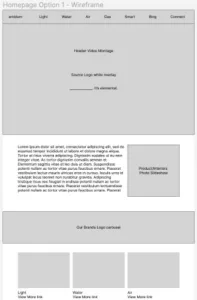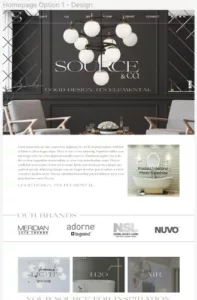A Simple 7-Step Custom Website Design Process
Your website is often the first and sometimes the only place people go to find out about your brand. So, it’s never been more critical to have a website that really works. A custom website design – one that blends technical performance with a unique, compelling brand voice – can be a powerful tool in maximizing the reach and success of your brand online.
Still, many clients are intimidated when they hear “custom website design”. After all, it sounds complicated not to mention labor and time-intensive. With smart planning and the right team however, creating and launching a new custom website design may be simpler than you think. At Clementine Creative Agency, our web team uses a simple 7-step website design process that can efficiently and effectively create a new custom site that’s ready to work hard for your brand.
- Step One: Planning Your New Website
- Step Two: Site Architecture & Wireframe
- Step Three: Visual Page Design
- Step Four: Page Development
- Step Five: Content Creation
- Step Six: Testing the Development Site
- Step Seven: Launch Your New Website
STEP ONE: PLANNING
The first critical step in any website design process is planning. A thoughtful and structured approach to your website project is the key to a strong foundation for success and sets the entire project down the right path from the start. There are a lot of things to think about during this stage so it’s great to have an expert team to offer guidance and input at this stage. Items we typically cover with clients include:
- Identifying Your Website Goals: What are your goals for your website? This may include performance goals (I want to generate more clicks and leads or I want to make my website easier for visitors to use), design and content goals (I want to tell my brand story in a more compelling way) or internal goals (I want my website to be easier to manage). Once you identify the specific goals that you want to accomplish with your new website, the rest of the process can stay focused on achieving those.
- Thinking About Your Audience: Who are you hoping to attract to the site? What do they expect? What action do you want them to take? As in every other facet of marketing, it’s critical to know and understand your audience as you set out to build a new website. Think about all the personas that make up your audience and what will resonate most with them as well as where the website fits into their journey with your brand. That is, is the website aimed at introducing your brand and getting them to take the next step to engage with you or is the website carrying them all the way through the purchase process?
- Benchmarking Competition: The planning stage is also a good time to take a look at your competition on the web as well as any other sites that you might find inspiring. By placing your new website in the context of your competition, you can better understand expectations that your audience may have based on who they’re shopping you against.
Another foundational part of the planning process is to decide on the website platform you will use. We recommend WordPress for most clients as it provides a good balance between flexibility, scalability for the future and ease of management, allowing you more control of your own website versus templated systems like Wix or Square Space (For more on the advantages of using WordPress, check out this article from web host Hostinger.)
STEP TWO: SITE ARCHITECTURE & WIREFRAME
Once you’ve identified your platform and site goals, it’s time to start on the building blocks of your new website. First, a documented set of page scope requirements is an invaluable guide to catalog all the specific needs and requirements for each page or type of page on the site. Once that is complete, it’s time to layout an overall site map to clarify the organization of all the pages on the site as well as the relationships and navigation between various pages. Our team works collaboratively with clients to complete this process and make sure that all the details are correct before moving on.
Next, it’s time to build a wireframe for the new site based on the finalized site map and page requirements. A wireframe blocks out the structure, layout and navigation for each page on the site. At this stage, you’re looking not for branded visuals, colors or imagery but instead using boxes and simple text to build a blueprint for the site’s pages.
STEP THREE: VISUAL PAGE DESIGN
With the wireframe set, it’s time to bring it to life with a full visual design. At this stage, colors, fonts, imagery and iconography are applied to the pages. This is your first glimpse of the full picture as the look, feel and functionality of the site are pulled together.
The visual page design stage requires a careful balance between compelling creative design and safeguarding the performance and accessibility of the site. That means thinking through optimization of image and video placements, keeping navigation and click actions clear and simple as well as balancing visual elements like color contrast, font size and menu layout that can impact your website’s overall accessibility to users. (Read up on more about web accessibility basics here.)
Once the visual design is ready, we provide clients with a styled prototype of their new website’s pages for easy review and refinement of the look and feel of each page before moving on to active page development.
STEP FOUR: PAGE DEVELOPMENT
Once the design is set and approved, it’s time to begin the business of actually coding and developing the pages of the website. In addition to bringing the functionality of the site to fruition, the page development process is also a critical time in establishing the foundation of the site’s technical performance which impacts not only the quality of experience that users will have on the site but is also a critical factor in strong organic SEO (or search engine optimization). In fact, Google uses its Core Web Vitals – including elements like page load times, page stability and page response times – as key ranking factors in its search engine results. The development stage is where the rubber first meets the road in crafting a high-performance website.
STEP FIVE: CONTENT CREATION
While page development is underway, content creation can also kick into high gear. This consists of writing and editing content for all of the site’s pages. It’s well known that incorporating relevant keywords into your website content is a critical part of organic SEO but that doesn’t mean just stuffing in keywords is the way to go. High quality, informative content incorporating your keywords in a strong contextual framework will provide the most SEO benefits over time. This is also the stage at which you ensure that other SEO fundamentals like page titles, header structure and meta descriptions are addressed as well as appropriate titles and alt text for images.
Once content is ready and page development is complete, it’s time to web optimize all of your content assets and load them to the website pages for review.

STEP SIX: TESTING
Page development is done and content is loaded. That means it’s testing time! Our team conducts detailed internal quality assurance testing to ensure that all pages meet the scope and requirements as defined at the beginning of the design process and that all pages, links, buttons and other site elements are working as intended across different web browsers and different devices. Once we’ve completed our check, we provide a test site link to our clients so that they can review the new site in its entirety to see how it works, feels and reads in a variety of environments.
STEP SEVEN: LAUNCH DAY
Once testing is complete and the new site is approved, launch day is on the horizon. It’s an exciting time but there are still plenty of details to be tended including getting all your applicable domain names set, ensuring any SEO redirects or change of address forms are implemented and making sure that all your pages are working properly and tracking is in place and active. Before you know it, your new site is live!
A lot of detail and expertise go into the custom website design process, but that doesn’t mean it has to be intimidating. With a strong focus on your website goals and the right team to put them into action, you can create a new custom website design that will both tell your brand story beautifully and work hard behind the scenes to drive your business goals.


